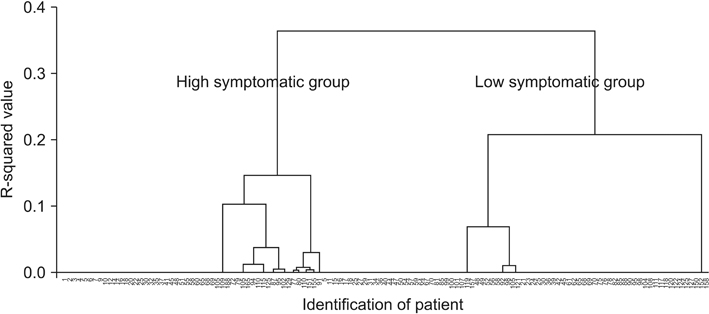Ann Surg Treat Res.
2018 Sep;95(3):135-140. 10.4174/astr.2018.95.3.135.
Postcholecystectomy syndrome: symptom clusters after laparoscopic cholecystectomy
- Affiliations
-
- 1Department of Surgery, Dongguk University Ilsan Hospital, Dongguk University College of Medicine, Goyang, Korea.
- 2Department of Surgery, Seoul National University Hospital, Seoul National University College of Medicine, Seoul, Korea.
- 3Department of Surgery, Samsung Medical Center, Sungkyunkwan University School of Medicine, Seoul, Korea. cardioman76@gmail.com
- 4Department of Biostatistics, Dongguk University Ilsan Hospital, Dongguk University College of Medicine, Goyang, Korea.
- 5Department of Surgery, Chung-Ang University Hospital, Chung-Ang University College of Medicine, Seoul, Korea.
- KMID: 2419443
- DOI: http://doi.org/10.4174/astr.2018.95.3.135
Abstract
- PURPOSE
Postcholecystectomy syndrome (PCS) is characterized by abdominal symptoms following gallbladder removal. However, there is no consensus for the definition or treatment for PCS. The purpose of this study was to define PCS among various symptoms after laparoscopic cholecystectomy, and to identify risk factors affecting PCS.
METHODS
This study was conducted at Dongguk University Ilsan Hospital and Chung-Ang University Hospital (2012-2013). Outcomes were assessed using European Organization for Research and Treatment of Cancer QLQ-C30 questionnaire. Symptom cluster for determining PCS was made by factor analysis. Cluster analysis evaluating risk factors of PCS was made by Ward methods and Dentogram.
RESULTS
Factor analysis revealed three distinct symptom clusters, those are "˜insomnia and financial difficulties (eigenvalue, 1.707; Cronbach α, 0.190),'"˜appetite loss and constipation (eigenvalue, 1.413; Cronbach α, 0.480),' and "˜right upper quadrant (RUQ) pain and diarrhea (eigenvalue, 1.245; Cronbach α, 0.315).' Among these symptom clusters, the cluster of "˜RUQ pain and diarrhea' was determined as PCS. However, we could not find any risk factors between high symptomatic group and low symptomatic group.
CONCLUSION
PCS could consist of RUQ pain and diarrhea. Well-designed prospective trials are needed to determine risk factors of PCS.
MeSH Terms
Figure
Reference
-
1. Jaunoo SS, Mohandas S, Almond LM. Postcholecystectomy syndrome (PCS). Int J Surg. 2010; 8:15–17.
Article2. McPherson K, Wennberg JE, Hovind OB, Clifford P. Small-area variations in the use of common surgical procedures: an international comparison of New England, England, and Norway. N Engl J Med. 1982; 307:1310–1314.
Article3. Lirici MM, Califano AD, Angelini P, Corcione F. Laparo-endoscopic single site cholecystectomy versus standard laparoscopic cholecystectomy: results of a pilot randomized trial. Am J Surg. 2011; 202:45–52.
Article4. Reynolds W Jr. The first laparoscopic cholecystectomy. JSLS. 2001; 5:89–94.5. Tiong L, Oh J. Safety and efficacy of a laparoscopic cholecystectomy in the morbid and super obese patients. HPB (Oxford). 2015; 17:600–604.
Article6. Han IW, Kwon OC, Oh MG, Choi YS, Lee SE. Effects of Rowachol on prevention of postcholecystectomy pain after laparoHongbeom scopic cholecystectomy: prospective multicenter randomized controlled trial. HPB (Oxford). 2016; 18:664–670.7. Kim GH, Lee HD, Kim M, Kim K, Jeong Y, Hong YJ, et al. Fate of dyspeptic or colonic symptoms after laparoscopic cholecystectomy. J Neurogastroenterol Motil. 2014; 20:253–260.
Article8. Dodd MJ, Miaskowski C, Paul SM. Symptom clusters and their effect on the functional status of patients with cancer. Oncol Nurs Forum. 2001; 28:465–470.9. Barsevick AM, Whitmer K, Nail LM, Beck SL, Dudley WN. Symptom cluster research: conceptual, design, measurement, and analysis issues. J Pain Symptom Manage. 2006; 31:85–95.
Article10. Fan G, Filipczak L, Chow E. Symptom clusters in cancer patients: a review of the literature. Curr Oncol. 2007; 14:173–179.
Article11. Ryu E, Kim K, Cho MS, Kwon IG, Kim HS, Fu MR. Symptom clusters and quality of life in Korean patients with hepatocellular carcinoma. Cancer Nurs. 2010; 33:3–10.
Article12. Steel JL, Kim KH, Dew MA, Unruh ML, Antoni MH, Olek MC, et al. Cancer-related symptom clusters, eosinophils, and survival in hepatobiliary cancer: an exploratory study. J Pain Symptom Manage. 2010; 39:859–871.
Article13. Wanjura V, Sandblom G. How do quality-of-life and gastrointestinal symptoms differ between post-cholecystectomy patients and the background population? World J Surg. 2016; 40:81–88.
Article14. Cho KS, Baek SY, Kang BC, Choi HY, Han HS. Evaluation of preoperative sonography in acute cholecystitis to predict technical difficulties during laparoscopic cholecystectomy. J Clin Ultrasound. 2004; 32:115–122.
Article15. Yun YH, Park YS, Lee ES, Bang SM, Heo DS, Park SY, et al. Validation of the Korean version of the EORTC QLQ-C30. Qual Life Res. 2004; 13:863–868.
Article16. Kim HJ, Abraham IL. Statistical approaches to modeling symptom clusters in cancer patients. Cancer Nurs. 2008; 31:E1–E10.
Article17. Gwede CK, Small BJ, Munster PN, Andrykowski MA, Jacobsen PB. Exploring the differential experience of breast cancer treatment-related symptoms: a cluster analytic approach. Support Care Cancer. 2008; 16:925–933.
Article18. Wilson RG, Macintyre IM. Symptomatic outcome after laparoscopic cholecystectomy. Br J Surg. 1993; 80:439–441.
Article19. O'Donnell LJ. Post-cholecystectomy diarrhoea: a running commentary. Gut. 1999; 45:796–797.20. Sauter GH, Moussavian AC, Meyer G, Steitz HO, Parhofer KG, Jüngst D. Bowel habits and bile acid malabsorption in the months after cholecystectomy. Am J Gastroenterol. 2002; 97:1732–1735.
Article21. Berger MY, Olde Hartman TC, Bohnen AM. Abdominal symptoms: do they disappear after cholecystectomy? Surg Endosc. 2003; 17:1723–1728.
Article22. Lamberts MP, Lugtenberg M, Rovers MM, Roukema AJ, Drenth JP, Westert GP, et al. Persistent and de novo symptoms after cholecystectomy: a systematic review of cholecystectomy effectiveness. Surg Endosc. 2013; 27:709–718.
Article23. Nagel GC, Schmidt S, Strauss BM, Katenkamp D. Quality of life in breast cancer patients: a cluster analytic approach. Empirically derived subgroups of the EORTC-QLQ BR 23--a clinically oriented assessment. Breast Cancer Res Treat. 2001; 68:75–87.24. McJunkin B, Fromm H, Sarva RP, Amin P. Factors in the mechanism of diarrhea in bile acid malabsorption: fecal pH--a key determinant. Gastroenterology. 1981; 80:1454–1464.
Article
- Full Text Links
- Actions
-
Cited
- CITED
-
- Close
- Share
- Similar articles
-
- Laparoscopic Resection for the Treatment of Symptomatic Remnant Huge Cystic Duct with Stone after Laparoscopic Cholecystectomy
- Laparoscopic Removal of a Retained Gallbladder with Remnant Cystic Duct Calculi
- The most frequent symptoms of postcholecystectomy syndrome for cholelithiasis patients older than 40 years of age
- Fate of Dyspeptic or Colonic Symptoms After Laparoscopic Cholecystectomy
- Laparoscopic Cholecystectomy in the Second Trimester of Pregnancy


